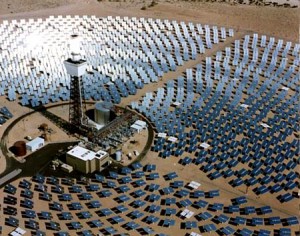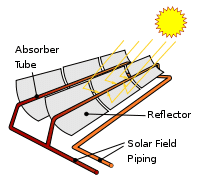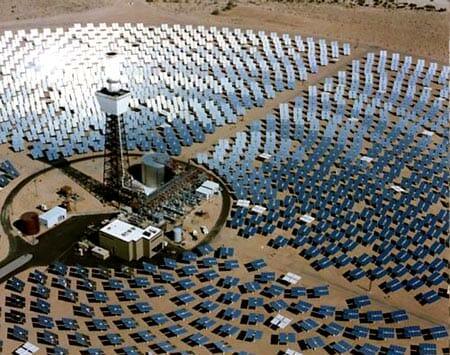Arizona is experimenting with some pretty exciting stuff! SOLON Corporation has developed a 1.6MW solar array whose energy output will be made available to Tucson Electric Power Customers beginning February 1, 2011, through TEP’s Bright Tucson Community Solar Program.

According to Solar Industry, “the 1.6MW array features SOLON’s Velocity MW Solar System, which provides preconfigured modular solar fields. The system incorporates 11 single-axis trackers, utilizing 5,808 275W solar modules.” This system is expected to provide power for 1,600 blocks of TEP customers. The energy from this system will be available in 150kWh blocks that will add a nominal $3 to each power bill.
As TEP expands its solar-generating resources, more blocks will become available for more customers. TEP plans to invest $28 million this year into the system, with plans in the following years that will increase the capacity of the system to 28MW.
And according to Reuter’s, the Department of Energy has just awarded a loan guarantee of $967 million to the Agua Caliente Solar project, a solar facility that will be built in Yuma County, Arizona and will have a 290MW capacity. The project will buy its panels from First Solar and expects completion of the facility around 2014. NRG Energy, Inc. acquired the project from First Solar last month.
Pacific Gas and Electric out of northern California plans to purchase the energy produced from the Yuma County facility. According to the president of NRG Energy, Inc., “The public private partnership between NRG Solar, First Solar and the Department of Energy will be instrumental in adding an unprecedented amount of emission-free solar power to America’s energy portfolio. Together, we will create hundreds of jobs and reduce the nation’s fossil fuel dependence and carbon intensity. Since clean solar generation availability tends to align with the periods of highest electricity demand, projects like Agua Caliente add natural peaking capacity to the grid.”
While these plants are not the first of their kind, they do show a continuing interest in alternative energy. The largest solar facility is located in the Mohave Desert. Because the solar radiation in the Mohave is the best in the United States, solar power plants in that area are a viable alternative to traditional means of generating electricity.
Normally, today’s solar facilities use what is known as “trough” systems to collect solar energy.

According to a Department of Energy overview, “trough systems convert the heat from the sun into electricity. Because of their parabolic shape, trough collectors can focus the sun at 30-60 times its normal intensity on a receiver pipe located along the focal line of the trough. Synthetic oil circulates through the pipe and captures this heat, reaching temperatures of 390 °C (735 °F). The hot oil is pumped to a generating station and routed through a heat exchanger to produce steam. Finally, electricity is produced in a conventional steam turbine. The SEGS plants are configured as hybrids to operate on natural gas on cloudy days or after dark, and natural gas provides 25% of the total output.”
The Mohave Desert solar facility uses a combined total of nine such trough power plants with a capacity of 354MW. This is enough power to meet the needs of approximately 500,000 households. It’s also the largest facility of its kind in the United States.
While these facilities are just the beginning of an alternative energy revolution (and don’t make a dent in switching over power plants to clean, alternative fuel sources), they do show innovation and hope that America can wean itself from foreign oil, foreign influence, and finite resources.
If you liked this article you may be interested in this product from our sponsor.











